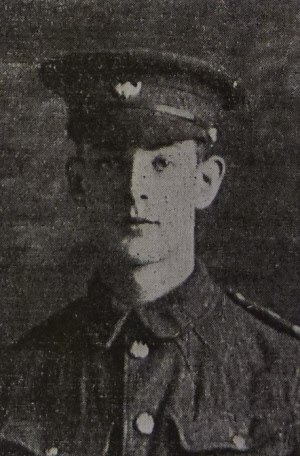
Alfred Gardham Burrill was born in Ossett in early 1896, the son of Mr Arthur Burrill and his wife Phillis (nee Scott), Springstone Avenue, Ossett, who had married a year earlier in Ossett. Alfred’s father Arthur was a gardener for Mr. Edward Clay at Wesley House, Ossett.
At the time of his enlistment in the King’s Own Yorkshire Light Infantry in February 1915, Alfred Burrill worked at Westwood’s colliery in Church Street and before that for a firm of local ironmongers.
The 1st/4th Battalion of KOYLI was formed in August 1914 at Wakefield and was part of the 3rd West Riding Brigade, West Riding Division. They moved on mobilisation to Doncaster and then in November 1914 to Gainsborough. The battalion moved again to York in February 1915 for training and on the 12th April 1915, they landed at Boulogne. On the 15th May 1915 the formation became 148th Brigade, 49th (West Riding) Division.
Private Burrill was posted to France at Christmas 1915, but was reported missing between the 1st and 8th of August 1916. He was later reported to have died whilst being held as a prisoner of war by the Germans on the 10th July 1916.1 It is likely that he was wounded during the Battle of Albert, the opening battle of the Somme between the 1st and 13th of July 1916. The 49th (West Riding) Division, to which the 1/4th Battalion of KOYLI was attached were heavily involved in the fighting.
The Battle of Albert attack on 1 July was made by eleven divisions along a fourteen mile front from Montauban to Serre. Haig hoped to capture the German front line along this entire front, then break through their second and third lines, before turning left and rolling up the German lines to the sea.
This would prove to be the most ridiculously optimistic plan. Along the northern two thirds of the front virtually no ground was taken. A few lodgements were made in the German front lines, but they were impossible to extend and difficult to support. The British suffered 57,000 casualties on 1 July, a costly day in British military history. Thirteen divisions at full strength contained 130,000 men, so the British suffered over 40% casualties in a single day.
Alfred Burrill was 20 years of age at the time of his death and he is buried at Lebucquiere Communal Cemetery Extension2, Pas de Calais, France at grave reference II. A. 21. Lebucquiere is a village 8 kilometres east of Bapaume and about 2 kilometres south of the main straight road from Bapaume to Cambrai. The communal cemetery extension was begun on 24 March 1917 and was used by the 1st Australian Division and other units for almost a year. After the reoccupation of the village in September 1918, it was used again for a fortnight. At the Armistice, the cemetery contained 150 burials, but it was then greatly enlarged when graves were brought in from the surrounding battlefields. The extension now contains 774 Commonwealth burials and commemorations of the First World War. 266 of the burials are unidentified but there are special memorials 20 casualties known or believed to be buried among them and to one soldier buried in Bertincourt German Military Cemetery, whose remains could not be found on concentration.
CWGC heastone photograph courtesy of Mark Smith
References:
1. “Ossett Observer”, 23rd September 1916 and 21st October 1916.